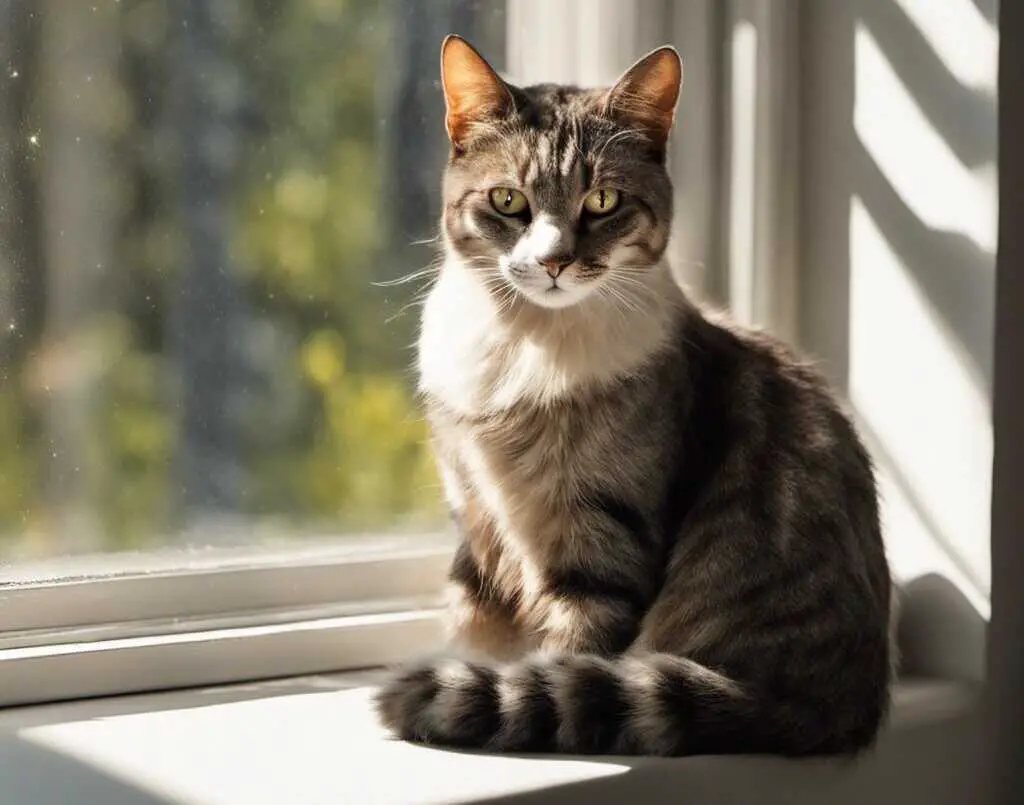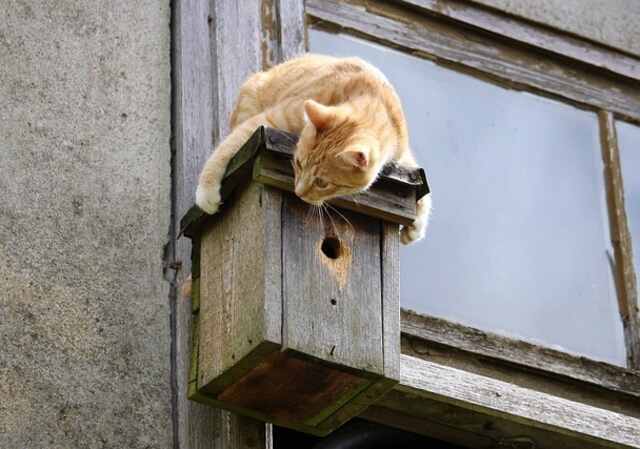For many cat owners, seeing their furry friend chase after birds can be an amusing and entertaining sight. However, have you ever wondered why cats have such a strong instinct to chase birds in the first place?
The truth is, cats are natural predators, and bird chasing behavior is a result of their hunting instincts. This behavior is deeply ingrained in their DNA and has been shaped by thousands of years of evolution.
In this article, we will delve deeper into the fascinating world of feline behavior and explore why cats chase birds. We will also discuss how cat owners can manage this behavior and the ethical considerations that come with allowing cats to interact with birds.
Table of Contents
- 1 Key Takeaways:
- 2 Why Do Cats Chase Birds?
- 3 Understanding Feline Instincts
- 4 The Predator Instinct in Cats
- 5 Hunting Instincts in Cats
- 6 Bird Chasing Behavior in Cats
- 7 The Fascination with Birds
- 8 Managing Bird Chasing Behavior
- 9 The Ethics of Cat and Bird Interaction
- 10 The Conclusion
- 11 FAQs: Why Do Cats Chase Birds?
- 11.1 Why do cats chase birds?
- 11.2 Are cats hardwired to hunt?
- 11.3 What is the predator instinct in cats?
- 11.4 How do hunting instincts influence cats?
- 11.5 Why are cats fascinated with birds?
- 11.6 How can cat owners manage bird chasing behavior?
- 11.7 What are the ethical considerations of cat and bird interaction?
- 12 Author
Key Takeaways:
- Cats have a natural instinct to hunt and chase prey, including birds.
- This behavior is a result of thousands of years of evolution and is deeply ingrained in feline DNA.
- Cat owners can manage bird chasing behavior by redirecting their hunting instincts.
- Allowing cats to chase birds can have ethical considerations, including impacts on bird populations.
Why Do Cats Chase Birds?
Cats are natural predators, and chasing birds is an instinctual behavior that is hardwired into their DNA. Even indoor cats may feel the urge to chase birds that they see through a window.
Hunting and stalking behaviors are important for a cat’s physical and mental well-being, and chasing birds provides a form of exercise and mental stimulation.
However, it’s important to keep cats indoors or supervise them when they are outside to prevent them from harming birds and other wildlife.
Understanding Feline Instincts
Cats are natural hunters, with a set of instincts and behaviors that have been shaped by thousands of years of evolution. These instincts are deeply ingrained in their behavior, making it difficult for them to resist the urge to hunt and chase prey, including birds.
One of the main instincts that drives cats to chase birds is their predator instinct. This instinct is common in all cats, whether they are domesticated or wild, and it is what makes them efficient hunters. The predator instinct allows cats to anticipate the movements of their prey, track them down, and pounce at the right moment.
The Predator Instinct in Cats
The predator instinct is so strong in cats that they will instinctively chase anything that moves quickly and unpredictably, such as a bird flying by. This is because their brains are hardwired to perceive such movements as potential prey. When a cat sees a bird, its predatory instincts kick in, and it will immediately start chasing it.
Another instinct that drives cats to chase birds is their hunting instinct. This is a natural behavior that all cats possess, and it allows them to track and catch prey efficiently. Hunting instincts include stalking, pouncing, and biting, and they are all used by cats to catch birds and other small animals.
Despite being domesticated, cats still have a strong connection to their wild ancestors, and their instincts have not been dulled by living with humans. This means that even if a cat has never been outside, it will still feel the urge to hunt and chase prey, including birds.
The Predator Instinct in Cats
As natural hunters, cats have a strong predator instinct that drives them to chase and catch prey. This instinct has been developed through evolution to ensure their survival in the wild. Even domesticated cats who have never had to hunt for their own food retain this instinct, which can manifest itself in a variety of ways.
The predator instinct is a deeply ingrained part of a cat’s behavior, and it is triggered by a variety of stimuli. For example, a bird fluttering by may catch a cat’s eye and activate their hunting instincts. The sight, sound, and movement of prey can all trigger a cat’s desire to give chase.
Once a cat begins to pursue a bird, their instincts take over. They may crouch down, stalk the bird, and then pounce with lightning-fast reflexes. Some cats may even use tactics like hiding in wait or playing dead to lure birds into their grasp.
It’s important to remember that this behavior is not a cat being malicious or cruel – it’s simply a natural instinct. Cat owners can help manage their cat’s predator instinct by providing them with toys and activities that allow them to release their hunting energy in a safe and controlled way.
The Role of Prey Instinct in the Cat and Bird Interaction
In addition to the predator instinct, cats also have a prey instinct that affects their behavior when interacting with birds. Prey instinct is the natural instinct of animals to avoid predators and flee from danger.
When a cat is chasing a bird, the bird’s prey instinct may kick in and cause it to try to escape. This can lead to a game of cat and mouse (or cat and bird) that can be both fascinating and dangerous to observe.
Cat owners should keep in mind that while it may be entertaining to watch their cat try to catch a bird, it’s important to prioritize the safety of both the cat and the bird.
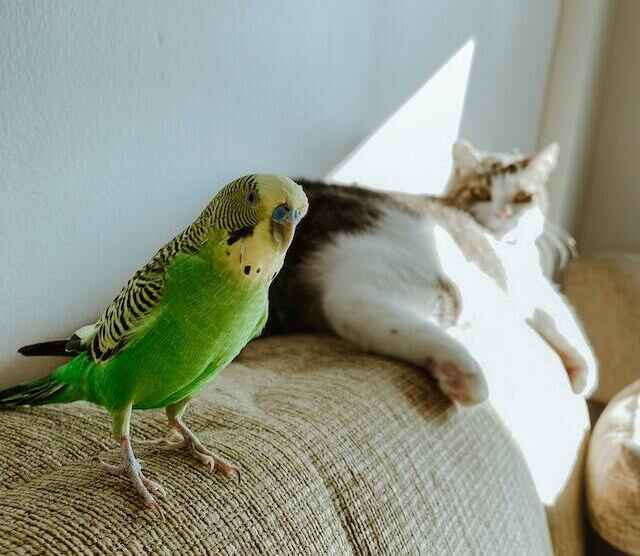
Hunting Instincts in Cats
Cats are natural hunters, and their hunting instincts have been shaped by generations of evolution. These instincts make them highly efficient predators, with a range of skills and techniques that are specifically adapted to catching prey. From their sharp claws and teeth to their incredibly sensitive hearing and vision, everything about a cat is designed to help it hunt.
One of the most important hunting instincts in cats is their ability to track and stalk prey. They have an almost supernatural ability to focus on a target, moving slowly and silently until they are within striking distance. This is aided by their flexible bodies, which allow them to move through tight spaces and make incredibly sharp turns.
Another key hunting behavior in cats is their use of ambush tactics. They are masters of surprise, hiding in wait until their prey is close enough to pounce upon. This requires a great deal of patience and discipline, as cats are capable of remaining still for long periods of time, waiting for the perfect moment to strike.
Cats also have highly developed senses that help them locate and track prey. Their eyesight is incredibly sharp, allowing them to see small movements from a great distance. They also have excellent hearing, with the ability to pick up the faintest of sounds. Finally, their sense of smell is also highly evolved, allowing them to detect the presence of prey even if it is hidden behind obstacles.
All of these hunting instincts and behaviors combine to make cats highly effective predators. While domestic cats may not need to hunt for food, they are still driven by these instincts to chase and catch small prey like birds.
Bird Chasing Behavior in Cats
When it comes to chasing birds, cats have a range of hunting techniques that they use. One of the most common is stalking, where cats move slowly and deliberately towards their prey, trying to get as close as possible before pouncing. Cats may also use their natural agility to leap and climb in pursuit of birds, often surprising them with sudden bursts of speed.
Another common technique used by cats is ambush hunting. This involves hiding in a spot and waiting for birds to come within reach, before attacking them quickly and decisively. This method requires patience and cunning, as cats must stay completely still and silent until the perfect moment to strike.
Some cats even use a combination of these techniques, depending on the situation. For example, they may stalk a bird for a while before switching to ambush mode once they get close enough.
It’s worth noting that not all cats are successful in catching birds. Even the best hunters can miss their mark, especially if the bird is quick and agile. However, the act of chasing and pouncing on birds is often reward enough for many cats, fulfilling their natural instincts as predators.
As a cat owner, it’s important to understand that bird chasing is a natural and instinctive behavior. While some people may find it concerning or even disturbing, it’s important to remember that cats are simply acting on their natural instincts.
Instead of trying to stop your cat from chasing birds altogether, it may be more effective to redirect their hunting instincts to other activities, such as playing with toys or hunting simulated prey.
The Impact of Bird Chasing on Wildlife
While bird chasing is a natural behavior for cats, it’s also important to be aware of the impact it can have on wildlife. Outdoor cats, in particular, can pose a threat to bird populations, as they may hunt and kill birds even if they don’t intend to eat them. This can have a significant impact on local bird populations, especially in areas where certain bird species are already endangered.
As a responsible cat owner, it’s important to take steps to minimize the impact of your cat’s hunting behavior on wildlife. This may include keeping your cat indoors, especially during times when birds are most active, or using a secure outdoor enclosure to provide your cat with access to the outdoors without putting birds at risk.
By understanding the natural instincts behind your cat’s bird chasing behavior, you can take steps to manage it in a way that is safe and responsible, both for your cat and for the wildlife in your area.
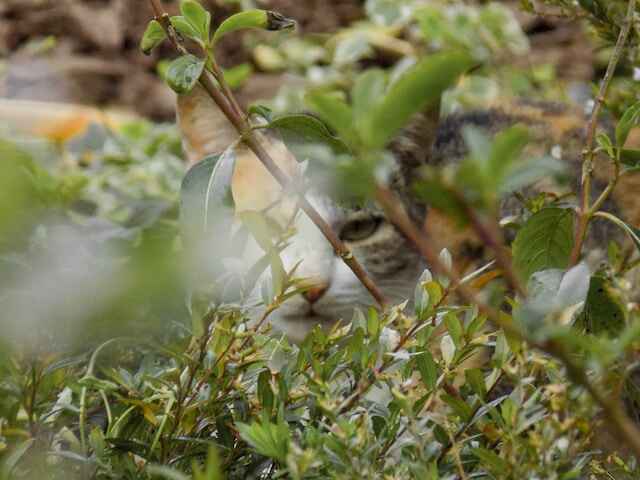
The Fascination with Birds
There’s no denying that cats have a fascination with birds, both as potential prey and as objects of curiosity. Many cat owners have observed their feline companions perched by a window, fixated on the fluttering wings of a bird outside.
This behavior can be traced back to the natural hunting instincts of cats. They are biologically wired to stalk, chase, and catch prey, and birds are no exception. Additionally, birds are often fast-moving and can provide an engaging challenge for cats, who are always on the lookout for exciting stimulation.
However, there may be other factors at play as well. Some experts believe that the color and movement of birds may trigger a cat’s innate predatory response, but others suggest that cats may also be simply drawn to the beauty and grace of birds.
Whatever the reason, it’s important for cat owners to manage their cat’s bird chasing behavior to prevent harm to both the cat and the bird populations in their area.
Managing Bird Chasing Behavior
As a cat owner, it’s important to understand that your cat’s bird chasing behavior is a natural instinct that they are hardwired to follow. However, it’s also essential to manage this behavior to ensure the safety of other animals and your cat. Here are some tips to help you manage your cat’s bird chasing behavior:
- Provide mental and physical stimulation: Make sure your cat has plenty of toys and opportunities to play to keep their mind and body active. A bored cat is more likely to engage in destructive behavior, such as bird chasing.
- Establish a play routine: Set aside specific times each day to play with your cat using toys that mimic prey animals. This will help redirect their hunting instincts away from birds.
- Limit access to birds: If possible, try to keep your cat indoors to prevent them from chasing birds outside. If you have an outdoor cat, consider using a harness and leash to keep them under control.
- Use deterrents: You can use deterrents, such as motion sensor sprinklers or noise machines, to discourage your cat from approaching areas where birds are present.
Remember, it’s essential to manage your cat’s bird chasing behavior to prevent harm to other animals and maintain a happy and healthy relationship between you and your cat.
The Ethics of Cat and Bird Interaction
While it is natural for cats to chase after birds, it is important for cat owners to consider the potential impact of this behavior on bird populations. Domesticated cats are not native to many environments they inhabit, and their hunting instinct can contribute to the decline of local bird populations.
According to the American Bird Conservancy, outdoor cats kill billions of birds every year in the United States alone. This is a significant concern for conservation efforts, particularly for endangered species.
So, what can cat owners do to mitigate the impact of their pets on local bird populations? One option is to keep cats indoors to prevent them from interacting with birds altogether. Another option is to use a leash or an enclosed outdoor space to allow cats to enjoy the outdoors while preventing them from hunting unsupervised.
Additionally, providing cats with toys and other enrichment activities can help redirect their hunting instincts and reduce the likelihood of them hunting birds. By understanding and managing cat behavior, pet owners can help protect local bird populations and promote coexistence between cats and wildlife.
The Conclusion
In summary, cats chase birds because of their natural instincts as predators. Feline instincts are hardwired to hunt and chase prey, which is why cats exhibit hunting behavior even when they are well-fed. The predator instinct in cats drives them to pursue smaller animals and catch them.
The hunting instincts of cats have been shaped by evolution to make them efficient predators. They use different techniques when chasing birds, such as stalking, pouncing, and ambushing. Cats are fascinated with birds because of their small size and the way they move, which triggers the cat’s hunting instincts.
If you are a cat owner, it is important to manage your cat’s bird chasing behavior. You can redirect their hunting instincts by providing them with appropriate toys and activities to keep them engaged and stimulated. Additionally, it is important to consider the ethical implications of allowing cats to chase birds and the impact it may have on bird populations.
The Takeaway
Cats chasing birds is a natural behavior that stems from their instincts as predators. By understanding their natural behavior, cat owners can manage their behavior effectively while still providing them with the appropriate stimulation they need.
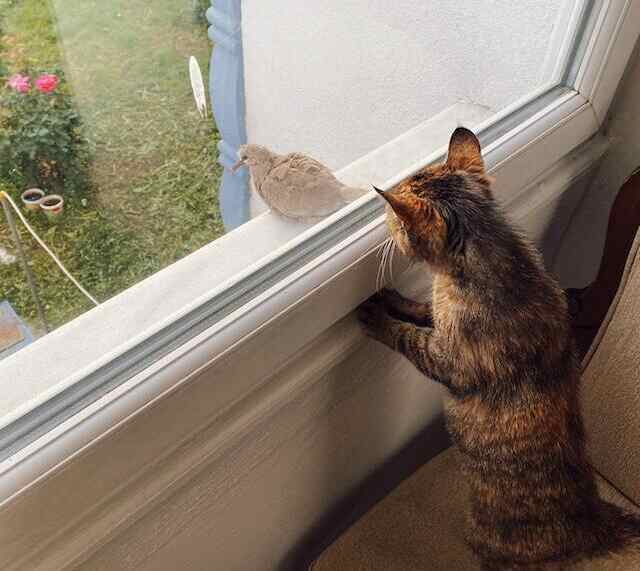
FAQs: Why Do Cats Chase Birds?
Why do cats chase birds?
Cats chase birds as a result of their natural predator instincts. Hunting and chasing prey is an innate behavior for cats, and birds are perceived as small, fast-moving targets that trigger their hunting instincts.
Are cats hardwired to hunt?
Yes, cats are hardwired to hunt. They have natural instincts that drive them to stalk, chase, and capture prey. These instincts have been developed through years of evolution and are deeply ingrained in their behavior.
What is the predator instinct in cats?
The predator instinct in cats refers to their innate drive to hunt and catch prey. This instinct is responsible for their behavior of chasing and pouncing on smaller animals like birds.
How do hunting instincts influence cats?
Hunting instincts play a significant role in a cat’s behavior. They affect their activity level, play behavior, and hunting techniques. Cats with strong hunting instincts may exhibit more intense bird chasing behavior.
Why are cats fascinated with birds?
Cats are fascinated with birds due to their natural instincts and the allure of their movement. Birds represent a challenging target for cats, as they can fly and are often seen as symbols of prey.
How can cat owners manage bird chasing behavior?
To manage bird chasing behavior, cat owners can provide alternative outlets for their cat’s hunting instincts, such as interactive toys and play sessions. It’s also essential to create an enriched environment to keep cats mentally and physically stimulated.
What are the ethical considerations of cat and bird interaction?
The ethical considerations of allowing cats to chase birds include the impact on bird populations, particularly for species that are already struggling. Cat owners should consider measures such as keeping cats indoors or using outdoor enclosures to minimize the impact on bird populations.

